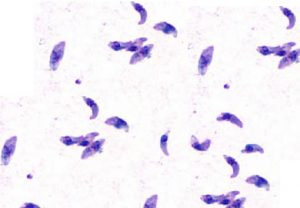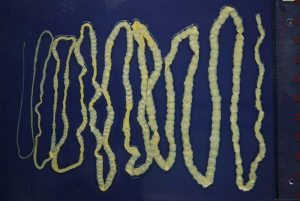Parasites are organisms that derive nourishment and protection from other living organisms known as hosts. They may be transmitted from animals to humans, from humans to humans, or from humans to animals. Several parasites have emerged as significant causes of foodborne and waterborne illness.
Foodborne parasites include protozoa (tiny, single-celled, microscopic organisms) and helminthes (larger, multi-cellular worms). The size ranges from 1 to 2 micrometers to 2 meters long. These organisms live and reproduce within the tissues and organs of infected human and animal hosts, and are often excreted in feces.
Example of common parasites.
1) Giardia duodenalis

This parasite can be found in the intestines of many herd animals (cows, sheep, goats, deer, and elk). The illness could be intestinal, tracheal, or pulmonary.
Common name of illness
- Giardiasis
Sources
- Drink contaminated water
- Consume uncooked meat that had been contaminated with G. duodenalis cysts (the infective stage of the organism).
- By putting anything into your mouth that has touched contaminated surfaces or the stool of a person or animal with giardiasis.
Sign & Symptom
- Diarrhea
- Abdominal cramps
- Nausea
- Chronic infection (dehydration and severe weight loss).
- Some cases may be without symptoms.
Safety Tips
- Wash hands with warm water and soap before handling foods and eating, and after going to the bathroom, changing diapers, and handling animals.
- Drink water only from treated municipal water supplies.
- Always cook your food to a safe internal temperature.
- Drink only pasteurized milk, juices, or cider.
- Wash, peel, or cook raw fruits and vegetables before eating
[collapse]
2) Toxoplasma gondii

This parasite can only carry out their reproductive cycle within members of the cat family. In this parasite-host relationship, the cat is the definitive host. The infective stage (oocyst) develops in the gut of the cat. The oocysts are then shed into the environment with cat feces.
Common name of illness
- Toxoplasmosis
Source
- Eat raw or undercooked meats, especially pork, lamb
- Drink untreated water that may contain the parasite.
- Fecal-oral: Touching your hands to your mouth after gardening, handling cats, cleaning a cat’s litter box, or anything that has come into contact with cat feces.
- Mother-to-fetus (if mother is pregnant when first infected with T. gondii).
Sign & Symptom
- Flu-like symptom (swollen lymph glands, muscle aches and pains).
- Persons with weakened immune systems (HIV/AIDS infection, organ transplant recipients, individuals undergoing chemotherapy) may develop severe toxoplasmosis which can lead to damage to the eyes or brain.
- Infants becoming infected before birth can be born retarded or with other mental or physical problems.
Safety Tips
- Wear clean latex gloves when handling raw meats
- Cook all raw beef, pork, lamb and veal steaks, chops, and roasts to a safe temperature.
- Wash hands, cutting boards, and other utensils thoroughly with hot, soapy water after handling raw meats.
- Wash hands thoroughly with warm water and soap after handling cats, cleaning cat litter boxes, especially before you handle or eat food.
- Feed cats commercially made cat foods or cook their food.
[collapse]
3) Taenia saginata

Taenia saginata (beef tapeworm) is a parasitic worm (helminths).
Common name of illness
- Taeniasis
- It is an intestinal infection caused by adult-stage tapeworms (beef tapeworms). Humans are the definitive hosts for this parasite. It grows and reproduce occurs only within humans.
Source
- Consume raw or undercooked infected beef
Sign & Symptom
- Most cases of infection with adult worms are without symptoms.
- Some may experience abdominal pain, weight loss, digestive disturbances, and possible intestinal obstruction.
- Irritation of the peri-anal area
Safety Tips
- Cook all raw beef to a safe internal temperature and measured with a food thermometer before removing meat from the heat source
[collapse]
4) Taenia solium

Taenia solium (pork tapeworm) is a parasitic worm (helminths). The definitive hosts is human
Common name of illness
- Cysticercosis
- It is the name of the tissue (other than intestinal) infection caused by the larval-stage of the pork tapeworm only.
Source
- Consume raw or undercooked infected pork
- By consuming food or water contaminated with the eggs of T. solium (pork tapeworm).
- By putting anything into your mouth that has touched the stool of a person infected with T. solium.
Sign & Symptom
- Muscles- lumps under the skin.
- Eyes- blurred vision
- Psychiatric problems
- Death
Safety Tips
- Do not eat undercooked pork or meat.
- Drink water only from treated municipal water supplies.
- Do not swim in community swimming pools if you or your child are infected with tapeworms.
- Do not swallow water while swimming.
[collapse]
